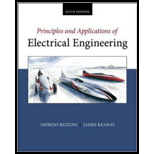
Concept explainers
Derive the expression for the voltage across a200-mH inductor when its current is:
a.
b.
c.
d.
Want to see the full answer?
Check out a sample textbook solution
Chapter 4 Solutions
Principles and Applications of Electrical Engineering
- Assume that the current flow through the resistor, IR, is 15 A; the current flow through the inductor, IL is 36 A; and the circuit has an apparent power of 10,803 VA. The frequency of the AC voltage is 60 Hz. ET ER EL IT IR15A IL36A Z R XL VA10,803 P VARSL PF Larrow_forwardInductive Circuits Fill in all the missing values. Refer to the following formulas: XL=2fLL=XL2ff=XL2L Inductance (H) Frequency (Hz) Inductive Reactance ( ) 1.2 60 0.085 213.628 1000 4712.389 0.65 600 3.6 678.584 25 411.459 0.5 60 0.85 6408.849 20 201.062 0.45 400 4.8 2412.743 1000 40.841arrow_forwardAssume that the voltage drop across the resistor, ER, is 78 V; the voltage drop across the capacitor, EC, is 104 V; and the circuit has a total impedance, Z, of 20 . The frequency of the AC voltage is 60 Hz. Find the missing values. ET ER78V EC104V IT IR IC Z20 R XC VA P VARSC PF Carrow_forward
- Using the phase shift of 72º from the Experiment, determine the inductance value, L, of the inductor shown. Vr(t) =3.7272 cos(4000 t - 72°) [V]arrow_forwardGiven V(t) = 3(5t + 2)V for 0 ≤ t ≤ 5s, find the current (I(t)) and charge (Q(t)) in capacitor with C = 900nF. Assume the capacitor is initially discharged (Vc(t<0) = 0V)arrow_forward3. Write the equation for capacitor voltage, v(t)=V0e−t/τ, for t≥0arrow_forward
- If a circuit is connected to a voltage source of 1sin(10t + 84 degrees) and Capacitance(C) = 2F, Resistance(R) = 6 Ohms and Inductance(L) = 5H. Find the instantaneous current flowing in the circuit at time t = 0.46 seconds. - Capacitor, Resistor and Inductor connected in seriesarrow_forwardA series L–R–C circuit has a supply input of 5 volts. Given that inductance, L = 5 mH, resistance, R = 75ohm and capacitance, C = 0.2µF, determine (c) the frequency at which the p.d. across the capacitance is a maximum and (d) the value of the maximum voltage across the capacitor. answer: c) 4741 hz, d)10.85voltsarrow_forwardThe voltage across a 75 mH inductor is described by the equation νL = (25 V) cos(60t), where t is in seconds.a. What is the voltage across the inductor at t = 0.10 s?b. What is the inductive reactance?c. What is the peak current?arrow_forward
- Find the impedance theoretically of a wire if it carries the frequency 10 kHz have a voltage is 8v, the current is 2mA, resistance is 12 kΩ , inductance 27 mH and capacitance 0.2 µfarrow_forwardH5. An RCL circuit connected in series has R = 180 ohms, C = 1/280 farad, L = 20 henries, and an applied voltage E(t) = 10 sin t. Assuming no initial charge on the capacitor, but an initial current of 1 ampere at t = 0 when the voltage is first applied, find the subsequent charge on the capacitor at t=0.5. Use 4 decimal places.arrow_forwardGiven the following pairs of voltages and currents, indicate whether the element involved is a capacitor, an inductor, or a resistor, and determine the values of C, L or R where ω= 157 rad/s a. v = 2000 sin ωt ; i = 5 cos ωt b. v = 80 sin(157t + 150°); i = 2 sin( 157t + 60°) c. v = 35 sin(ωt − 20°); i = 7 cos( ?? − 110°)arrow_forward
 Delmar's Standard Textbook Of ElectricityElectrical EngineeringISBN:9781337900348Author:Stephen L. HermanPublisher:Cengage Learning
Delmar's Standard Textbook Of ElectricityElectrical EngineeringISBN:9781337900348Author:Stephen L. HermanPublisher:Cengage Learning
